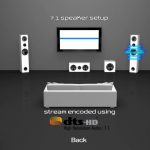Walk into the world of your favorite movies and songs with the new Dolby MAT technology from Dolby Laboratories. This new tech doesn’t just make the sound better; it changes how you hear everything with amazing 3D sound on all kinds of devices, and even adds special effects that make it feel like the sound is coming from above.
Dolby MAT stands for Metadata-enhanced Audio Transmission. It has changed the way we hear sound by making regular PCM audio richer and clearer, adding a new layer to how we experience sound. In this article, we’ll take a close look at Dolby MAT, how it works, and everything important you need to know.
Join us as we step into a magical world where the sound is about to become something entirely different.
Unlocking the Secrets of Dolby dolby Atmos MAT

The Dolby MAT technology delivers a richer sound out of even PCM audio with added depth and enhanced clarity. It essentially serves as both an encoder and a decoder for Dolby TrueHD bitstreams, facilitating communication between different devices. Dolby MAT employs special algorithms that blend the multiple audio channels transmitted from the source device into a single multi-channel audio track. It combines lossless PCM audio with Dolby Atmos metadata to produce the final 3D surround sound effects.
This track allows the soundbar connected to produce an object-based 3D surround sound without needing multiple speakers. The resulting audio has improved stereo imaging, profound bass response, clearer dialogues, and integrated height effects.
A key advantage of Dolby MAT 2.0 is its reduced latency in data transmission to the source device, thanks to its real-time, dynamic encoding. That even makes the processing less complicated.
Although Dolby MAT can work with PCM audio, you should be careful when choosing connected devices. For instance, it’s imperative that your source device is able to use Dolby MAT technology for encoding audio signals. Additionally, your speaker must support Atmos to produce the final 3D sound.
If there’s a loop in any of the connected devices, the entire Dolby MAT setup will fall flat.
Which devices do you require to enable Dolby MAT?
Let’s take a closer look at how Dolby MAT transmits data over connected devices to produce 3D sound effects.
- The Dolby MAT technology is basically integrated into Blu-ray players, game consoles, or set-top boxes.
- This device is connected to a Dolby-supported speaker or soundbar, which acts as a receiver. These devices decode the signals coming from the Dolby integrated players to produce 3D object-based surround sound.
- The network also includes a mandatory source device incorporating a Dolby MAT encoder. This device will help transmit Dolby TrueHD bitstreams to the Hub device (the Dolby MAT integrated device).
- You must connect your source device and the soundbar using a high-quality HDMI cable.
The source device, e.g., the TV, must be connected to the Dolby MAT integrated audio system – the speaker or soundbar. However, the setup might vary depending on the specific system.
For instance, if you want to connect your TV, a Blu-ray player, and a soundbar, you must connect your TV directly to your Dolby-enabled soundbar instead of the Blu-ray player. The soundbar should then be connected to the Blu-ray player, where resides the Dolby MAT technology.
This order of devices will pull off the optimal results of your Dolby MAT network.
Since it is mandatory to use Dolby-enabled devices for unlocking Dolby MAT magic, you must consult the user manual before connecting the devices for MAT compatibility.
How does Dolby MAT actually work?
- The Dolby MAT encoder essentially takes the Dolby TrueHD audio bitstream input from a Dolby enabled audio system. This system is, in turn, connected to the source, such as the TV.
- This encoder takes the Dolby Atmos metadata from the input (the Dolby-enabled soundbar) and converts it into LPCM audio signals. The audio signals are packed with Dolby Atmos metadata for the output.
- These packed audio signals are then transmitted via an HDMI connection to the receiving devices, such as TVs or soundbars, which act as decoders.
- The receiver device decodes the transmitted bitstreams further to process an object-based audio output A Dolby TrueHD experience for a 3D surround sound experience.
Bear in mind that the TrueHD bitstream will be contained within MAT frames, and the AV receiver will perform the decoding.
The next-level Dolby MAT 2.0
As Dolby Labs relentlessly pursues innovation to achieve exceptional outcomes, the emergence of Dolby MAT 2.0 stands as a testament to its unwavering commitment to bringing the audio experience to the next level.
Dolby MAT 2.0 elevates the experience by offering faster processing and the impressive ability to encode Dolby Atmos audio in real time.
Now what does that mean?
It ensures that when you’re streaming or playing content, the Dolby Bitstream travels seamlessly from your source device without annoying hiccups or noticeable delays. It’s all about delivering that smooth, uninterrupted audio experience you deserve.
In addition to its compatibility with TrueHD codec, Dolby MAT 2.0 goes a step further by supporting the Dolby Atmos sound format. This grants Dolby MAT 2.0 the ability to effectively handle Dolby Atmos metadata that is embedded within the conventional lossless PCM audio. This provides exciting capacity for seamless processing of immersive audio experience provided by Dolby Atmos while still maintaining the uncompressed audio signals.
Furthermore, with Dolby MAT 2.0, you get an edge to have smooth processing without any complexities that are a staple to traditional analog to digital transmissions.
Lastly, the Dolby MAT 2.0 leverages the full potential of the HDMI connection for smooth and glitch-free encoding/decoding. Therefore, it is mandatory to use a high-quality HDMI connection.
Popular Dolby-enabled devices
The modern market is flooded with Dolby-enabled devices. Some popular brands like Onkyo, Samsung, and Yamaha fully support Dolby MAT and are widely used for it.
In addition to that, there is a large variety of game consoles available in the market that are compatible with Dolby MAT, namely Apple products such as iPads, iPhones, iPods, Apple TV 4K, Microsoft Xbox 360, Xbox One X, Xbox One S, and so on.
Potential Future Developments in Dolby MAT Technology
Dolby MAT, with its sophisticated encoding and decoding mechanisms, is at the forefront of transforming auditory experiences. As we look towards the future, we can anticipate several potential advancements and refinements in Dolby MAT technology.
- Enhanced Real-Time Processing: Future iterations of Dolby MAT may focus on further reducing latency in real-time processing, allowing for even smoother, more synchronous audio experiences, especially critical in live performances or broadcasts.
- Adaptation to Varied Audio Formats: The adaptability of Dolby MAT to various audio formats is likely to expand, making it more versatile and ensuring compatibility with emerging audio formats, potentially even those designed for virtual or augmented reality environments.
- Advanced Metadata Handling: Enhanced metadata handling capabilities might be developed, allowing for richer and more detailed soundscapes. This could include dynamic adjustment of audio elements based on user preference or environmental acoustics, providing a more personalized listening experience.
- Energy Efficiency: Energy-efficient encoding and decoding algorithms may be developed to reduce the power consumption of devices utilizing Dolby MAT, prolonging battery life and reducing energy costs.
- Integration with AI Technologies: Integration with AI could allow Dolby MAT to offer predictive and adaptive audio experiences, adjusting sound profiles based on user behavior and preferences, and even environmental noise levels, without manual intervention.
Conclusion
In a nutshell, we can assert that Dolby MAT is a next-level venture from Dolby Labs that dynamically encodes and decodes conventional PCM audio to produce 3D surround sound effects. Its speed and reduced complexity are commendable.
The Dolby MAT technology is primarily integrated into devices like Blu-ray players, game consoles, or set-top boxes, which are then connected to an audio-output device.
All the connected devices must be Dolby-enabled to unlock the full potential of Dolby MAT.
It serves as a powerful tool for elevating your audio experience, especially in a home theater setting, to a level where you feel truly immersed in the sound.
Frequently Asked Questions
Dolby MAT is a revolutionary technology designed to enable users to experience 3D surround sound with PCM audio, blending multiple audio channels into a single track to produce enriched and immersive audio experiences.
While Dolby MAT is a codec that supports uncompressed Dolby Atmos along with uncompressed PCM audio, Dolby Digital+ (DD+) is another codec used by streaming services that compresses the audio to allow Dolby Atmos and/or Dolby Digital pass-through due to bandwidth constraints.
Yes, Dolby MAT is generally considered to provide superior audio quality compared to DD+ as it supports uncompressed audio, offering richer and more detailed soundscapes.

I’m Shaun Conroy, an audiophile & founder of HiFi Audios. Holding a Bachelor’s in Sound Engineering, I bring deep expertise in audio devices and offer insights & recommendations to fellow enthusiasts.





